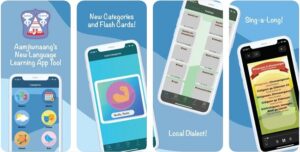Aamjiwnaang First Nation goes digital as it launches new language app

By Colin Graf
AAMJIWNAANG FIRST NATION— Learners of all ages in Aamjiwnaang First Nation are harnessing the power of modern technology to learn their ancestral language.
Along with some expert help, teachers and early childhood workers have crafted an Anishinaabemowin language phone app featuring local speakers to help with revitalizing the language for students from pre-school to adult.
The app, Aamjiwnaang Da Anishnaabemying (Aamjiwnaang, Let’s Speak Ojibwe), has been two years in the planning and creation stages, says Jessie Plain, the community’s Language & Culture Administrator. It is now available for Apple Devices at the App Store, but the rollout for Samsung and other Android devices has been delayed by the coronavirus disease 2019 (COVID-19) pandemic. The app’s builders, Ogoki Learning Inc. of Winnipeg, have had to close their offices due to a recent lockdown in Manitoba, Plain explains.
Opening the app, users are greeted with a colourful opening page and directions to 23 topics from daily life, such as greetings, weather, family, food, and useful expressions.
“You have the option to both see and hear” the words and expressions, Plain says, as the app presents you with the printed words and the words spoken by an authentic Anishinaabemowin speaker.
While other Ojibwe language apps already exist, Plain says educators at Aamjiwnaang noticed the dialects in other apps were different from local speakers and wanted to design their app particularly for the community’s kindergarten and day-care students.
Work on the app began in 2019, preparing word lists, organizing the lyrics for familiar children’s songs to be included, and recruiting speakers. Songs and nursery rhymes include Mna Dibishkaa Gizzhgad (Happy Birthday), Nangoons, Nangoons (Twinkle, Twinkle), and Mdweston Tataaganan (Jingle Bells). Plain says other Anishinaabemowin apps were not using songs, while she finds them to be a powerful teaching tool and really wanted them included.
The new app is only one way the community is promoting language learning. Her group is engaged in several projects, including the creation of a “language nest” at the community childcare center where “the majority of instruction and interaction will be in Anishinaabemowin,” Aamjiwnaang’s Education Coordinator Vicki Ware said earlier this year. The educators have had help from their counterparts at Chippewas of the Thames First Nation who are running an Ojibwe language immersion program at Antler River School, Ware said.
According to Plain, workers are also trying to engage parents in their efforts, through methods such as sending Ojibwe language books to read at home. Indigenous Education Workers and language teachers in local elementary and secondary schools are also able to use the app.
To help parents, Plain says there is both a need and desire for adult language teaching in Aamjiwnaang. Even though the app is primarily intended for early learners, “a lot of community members are requesting ways to learn the language,” and so a new emphasis is being placed on helping older learners.
The app will also play the songs in a vehicle and does not require Wi-Fi or data access after installation, making it helpful for parents, grandparents or other adults on the go.
The voices on the app include three Aamjiwnaang Elders, retired Anishinaabemowin teacher Pauline Williams, and Aamjiwnaang hereditary Chief Wilson Plain Sr. and his late wife Ada Plain. Other speakers are daycare supervisor Leanne Williams, Indigenous Education Worker Talon White-Eye, Language and Culture daycare Teacher Tammy Plain, Sophie Solares from the community’s well-baby drop-in center, and Jessie Plain.
The app was first released in November at Aamjiwnaang’s Language and Cultural Gathering, a three-day event featuring workshops on health, culture and language. The Gathering was originally planned for May but was then moved online due to the pandemic. The theme was “revitalizing our language and healing through culture,” according to promotional material.
The education workers have received positive feedback about the app so far, and have discussed expanding it by adding new categories, but Plain does not expect that will be happening soon. Videos from the Gathering workshops will be used in creating a documentary about language revitalization in Aamjiwnaang by Bkejwanong (Walpole Island First Nation) filmmaker Derek Sands of Indigital Films.
Last spring, the First Nation’s Education Department released a previous Sands film, documenting the making of maple syrup by Aamjiwnaang Elders and brothers, Roger and Rudy Williams. The film features a visit by the community’s 2019 Kindergarten class, Binoojiinyag Kino Maagewgamgoons, to the sugar bush.
The new app’s builders, Ogoki, have helped create over 170 language apps and interactive learning tools for schools and First Nations across Turtle Island. The company’s apps have been featured on the front page of Apple iTunes nine times.


